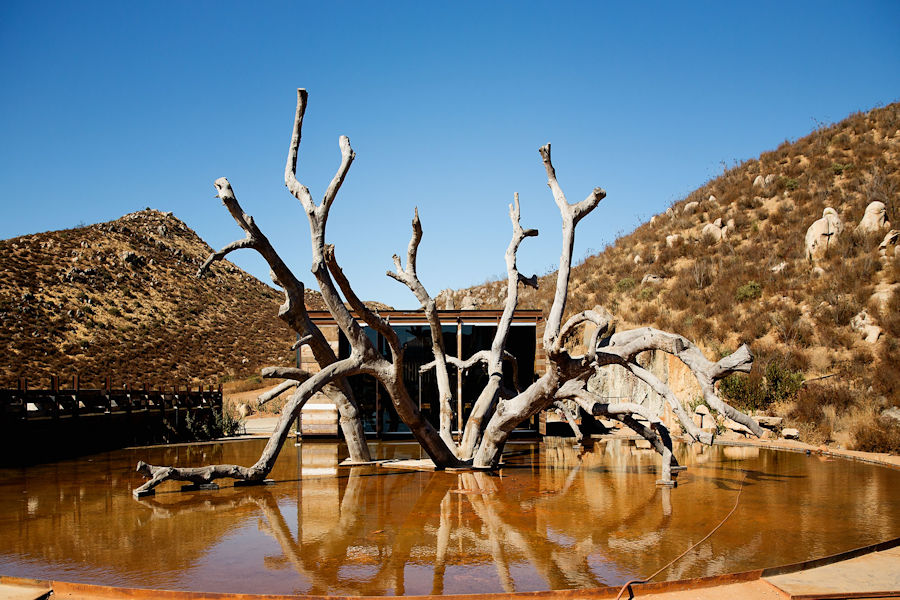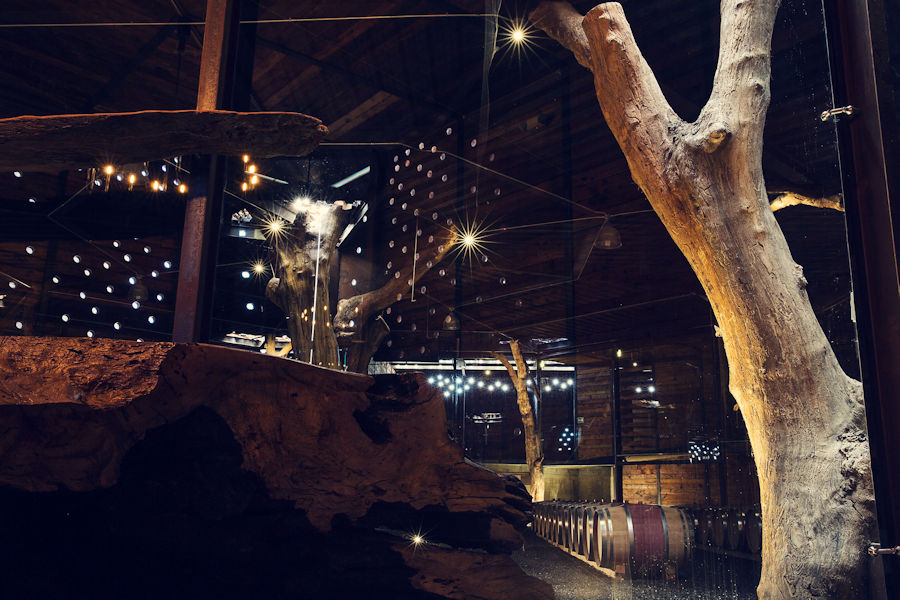 |  |
Highway 3 cuts through the wine country. It is fall and just after a late harvest. The vines are showing the first signs of ending their cycle; the leaves beginning to wither and brown. We turn off the main road and through the impressive rock entrance of Bruma Vinícola. The wide washboard lane is a slow go, but allows for taking it easy through the vineyard. This is working country. The field hands are just building their little fires to warm the tortillas for lunch and they wave as we pass by. There is a feeling of quiet country as the shadow and sunlight dance through the olive trees lining the road. A little sign points the way at the Y into an open valley of scrub sharing space with vines. The buildings are nestled in the foothills and as we near we see a stand of ancient oaks with huge trunks, still clinging to life. At one time, this area had dense groves of California Coastal Oak, which was the main food source for the Kumiai Indians.
The tasting room from the exterior does not convey the surprise upon entering. It is the featured attraction here at Bruma. This project was designed by the very well-known architect Alejandro D’Acosta. D’Acosta is known for his passion for using natural building materials of stone and soil, but even more, his vision is seen in the use of what has been discarded or thought to be of no value. He has a number of completed projects of unique beauty in the Guadalupe Valley and Bruma is his most recent.

The general wine tasting takes place on the ground level, taking in Alejandro’s extraordinary idea of using a 300-year-old oak tree that had died; literally tons of building material as seen through his eyes. First the branches were cut from the massive trunk. The branches were the size of a tree themselves. The trunk was hauled to the location to be used as the center of the production and tasting room. The project was built around it, using the branches as further weight-bearing timbers. The sleeping barrels are held inside an all glass cava, with the effect of looking into a chilled “fish bowl.” Subdued lighting completes the other-worldly and quite romantic effect. On an upper floor, the VIP lounge in the evenings is something to experience. Glowing red lighting on a natural oak sculpture combines with watery reflections and D’Acosta skillfully transports us into his visionary world.
Jose Luis greets us and introduces the wines for this day. While Burma just opened a year ago, their vineyard had been producing grape for a number of years. While he tells the story of how all this came to be, he pours a Chenin Blanc 2017 that has not passed through the barrel. He believes, like many other wineries in the valley, that it their job to introduce the Mexican people to wine. For many have been raised in a country famous for good beer and tequila and drinking con gusto. He says wine is more about savoring the taste and the social ambiance, rather than the fire of a good tequila. The Chenin Blanc is fresh with a bit of green apple acidity, finishing smooth and buttery; great for a warm summer’s day. We move on to a 100% Cabernet Sauvignon, 2014, “Plan B”. This also has not spent any time in the oak barrel. A young wine with red fruit forward, a hint of pepper at the finish and nice for a picnic with burgers on the grill. The featured premium reserve is a 2016 blend of Tempranillo, Cabernet Sauvignon and Merlot with 18 months in French oak. This was the winner for the tasting, deep and rich as only time in the barrel can produce. We taste a note of wood, a hint of Chocolate and only a refined palate caught the tobacco. Before we leave, we want to revisit some of the fine art that is also part of Burma’s magic. A large panel of dark glass allowed light to shine through hundreds of tiny openings, as if looking into the heavens on a moonless night, called “Star Light,” it was stunning. Powerful sculptures of metal and fibers and sharks swim overhead, carrying out the fish bowl theme.

Just outside of the tasting room is the Fauna restaurant and lush organic gardens tended with the purpose from which to create the menu. David Castro Hussong and Maribel Aldaco Silva create unique dishes from what nature provides each day. David says, “We apologize first-hand because we never really know what we will be serving, but this is where the fun begins, the thrill of cooking what’s at hand.” And Maribel adds, “We do native cuisine in constant transformation, for as we respect tradition, we never stop discovering flavors and updating in trends.” In an Oct. 19, 2018 San Francisco Chronical article, “This Baja wine region is the Napa Valley of Mexico,” freelance writer, Jill Robinson, spent time in the valley researching her story. She writes, “It’s easy to lose track of time at Fauna, the restaurant at Bruma Vinícola that causes nearly everyone I speak with during my time here to sigh wistfully. Less than 2 years old, the upscale restaurant has vibrant tile accents, recycled wood family-style tables, floor-to-ceiling windows and what seems like hundreds of tiny porthole windows that let in dots of light. But it also has chef David Castro Hussong and his experimental menu that changes daily. After a number of courses, I know now why so many people sigh about Fauna.” But of course, it is the whole experience of the land, the people and their passion for wine making which combines in bringing us back to this place, south of the border, to find truly unique surprises in every bend in the road.
Article by Martina
Photography by Cintia Soto

Have used different times with different vehicles and each time was very simple - each time we have...

Very clean, well kept/landscaped/maintained property. Excellent food, drink as well as friendly...

Easy easy easy... I have my co pilot (wife) set it all up on the drive south to the border. With in...